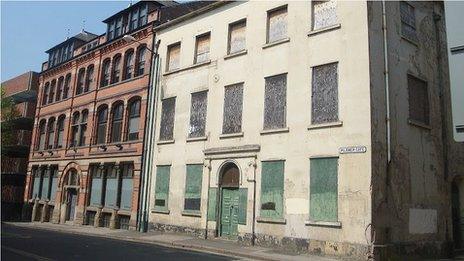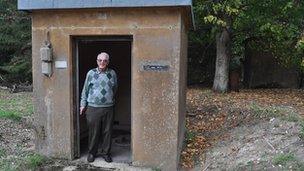England's heritage: Saving at risk listed buildings
- Published
- comments

Buildings at risk include the oldest residential house in Nottingham built between 1690 and 1700
A national public body has announced plans to attempt to save England's Grade II listed buildings from the threat of neglect.
English Heritage (EH) is calling on members of the public to assess Grade II listed buildings in their area and flag up if they think they are falling into disrepair.
There are 345,000 Grade II listed buildings in England and the body has extended its Heritage at Risk Register, external to include these types of sites for the first time.
The list already covers Grade II buildings in London and Grade I and Grade II* buildings in the rest of England but the list is expected to increase as Grade II buildings account for 92% of all those listed.
Heritage treasury
Buildings already identified as "at risk" include the oldest house in Nottingham, a women only lido in Reading and a bomb store in Suffolk.

A monument to the Cold War has been identified as at risk
EH was at the nuclear bomb facility at Barnham to launch the scheme.
John Ette, inspector of monuments for English Heritage, said: "We've always targeted Grade I, Grade II* and scheduled monuments, but this year we're targeting Grade II listed buildings via a series of pilot studies to extend what we're learnt.
"We're working with local authorities, building preservation trusts or owners to look at what we can do with the Grade II ones, so we'll try to do up to 15 pilot studies to see what we can learn."
Simon Thurley, chief executive of English Heritage, said: "Grade II buildings are the bulk of the nation's heritage treasury.
"When one of them is lost, it's as though someone has rubbed out a bit of the past - something that made your street or your village special will have gone."
To begin the project, EH has earmarked £250,000 to run the pilot surveys.
Edward Impey, director of heritage protection for English Heritage, said they would choose a diverse range of areas including urban, rural and those with higher economic challenges for the scheme which will run for a year.
EH staff have been redeployed in new Heritage at Risk teams in each of EH's nine local offices to work exclusively on supporting owners, developers, local authorities and volunteers in rescuing buildings so they can be removed from the list.
Case-by-case
Mr Impey said: "The point of the list is to catch things early - some Grade II buildings don't exist any more.
"We don't know how many buildings are at risk but our ambition is to assess them all and look at how many are deemed to be at risk.
"The first thing we need to know is their condition on a case-by-case basis."
EH will publish an assessment guide online so people can review a building from the outside and gauge if it is at risk.
He said: "We'll ask them things like: 'Is it occupied, has it got broken windows and plants growing out of the gutters?'."
Once a building is submitted it will be assessed by English Heritage who will work with funding bodies and local authorities and groups to try to put together a restoration programme.

Not all of the at risk sites are traditional buildings
But EH will not be able to fund all of the work - the body has seen its own budget cuts from £30m in 1999 to £12.5m.
And while in the past developers might repair a building knowing they could sell it and recoup their costs, the "conservation deficit" has rocketed during the recession.
From 2007 to 2012 the deficit - which is the shortfall between the cost of repairs and the money an owner could expect to recoup from the market value of a repaired property - increased from £330m to £423m. The average deficit per site rose from £267,000 to £366,000.
But Mr Impey said despite budgets being squeezed he still believed people were interested in saving buildings.
"Its difficult for local authorities because they are very hard pressed and there are fewer conservation staff but that doesn't mean the will isn't there," he said.
"English Heritage funds have diminished too but there are other sources of money and people are very good at raising money.
"The whole thing depends on people's enthusiasm but people in England are very passionate about our historic buildings."
- Published12 October 2012
- Published6 October 2012
- Published28 September 2012
- Published6 September 2012
- Published29 July 2012